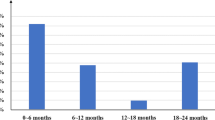Abstract
To determine the incidence of tinea capitis in São Paulo, Brazil, an investigation was performed in Private and Public Pediatrics Service involving 4,500 children from 0 to 15 years old during 5 years (1996–2000). Samples were taken from 132 children with suspected fungal infection of the scalp, for direct microscopy and culture. Tinea of scalp was mycologically confirmed in 112 patients (85%). Males were more affected than females in all age groups. Children below 8 years old accounted for more than 75% of the occurrences. Only three cases of tinea capitis were diagnosed in children from 12 to 15 years of age. Tinea capitis was prevalent in 103 cases (91.96%); inflammatory kerion type lesions were diagnosed in 9 patients (8.04%). Microsporum canis (70.5%) and Trichophyton tonsurans (23.2%) were the most common agents followed by T. mentagrophytes (3.6%), M. gypseum (1.8%) and T. rubrum (0.9%).
Similar content being viewed by others
References
PA Chinelli A Sofiatti RS Nunes et al. (2003) ArticleTitleDermatophyte agents in the city of São Paulo, from 1992 to 2002 Rev Inst Med Trop São Paulo 45 IssueID5 259–263 Occurrence Handle14743665
J Yu R Li G Bulmer (2005) ArticleTitleCurrent topics of Tinea capitis in China Nippon Ishinkin Gakkai Zasshi 46 IssueID2 61–66 Occurrence Handle15864248
JL Blumer (1999) ArticleTitlePharmacologic basis for the treatment of Tinea capitis Pediatr Infect Dis J 18 IssueID2 191–199 Occurrence Handle10048701 Occurrence Handle1:STN:280:DyaK1M7ls1Crug%3D%3D Occurrence Handle10.1097/00006454-199902000-00027
AK Gupta RC Summerbell (2000) ArticleTitle Tinea capitis Med Mycol 38 IssueID4 255–287 Occurrence Handle10975696 Occurrence Handle1:STN:280:DC%2BD3M%2FmslahsQ%3D%3D
AJ Pomeranz SS Sabnis (2002) ArticleTitleTinea capitis: Epidemiology, diagnosis and management strategies Pediatr Drugs 4 IssueID12 779–783
MC Attapattu (1989) ArticleTitleA study of Tinea capitis in Sri Lanka J Med Vet Mycol 27 IssueID1 27–32 Occurrence Handle2754578 Occurrence Handle1:STN:280:DyaL1MzivVOgsw%3D%3D
RS Brilhante RA Cordeiro MF Rocha et al. (2004) ArticleTitleTinea capitis in a dermatology center in the city of Fortaleza, Brazil: The role of Trichophyton tonsurans Int J Dermatol 43 IssueID8 575–579 Occurrence Handle15304180 Occurrence Handle10.1111/j.1365-4632.2004.02150.x
JI Figueroa T Hawranek A Abraha et al. (1997) ArticleTitleTinea capitis in south-western Ethiopia: A study of risk factors for infection and carriage Int J Dermatol 36 IssueID9 661–666 Occurrence Handle9352406 Occurrence Handle1:STN:280:DyaK1c%2FhtlKrsQ%3D%3D Occurrence Handle10.1046/j.1365-4362.1997.00236.x
D Borelli (1954) ArticleTitleNueva técnica sobre el cultivo de los hongos frágiles Rev Policl Caracas 131 285
P Dalgaard (2002) Introductory Statistics Springer – Verlag New York
CL Bergson NC Fernandes (2001) ArticleTitleTinea capitis: Study of asymptomatic carriers and sick adolescents, adults and elderly who live with children with the disease Rev Inst Med Trop São Paulo 43 IssueID2 87–91 Occurrence Handle11340482 Occurrence Handle1:STN:280:DC%2BD38%2FgvFKltw%3D%3D
D Devliotou-Panagliotidou T Koussidou-Eremondi GC Chaidemenos et al. (2001) ArticleTitleTinea capitis in adults during 1981–1995 in northern Greece Mycoses 44 IssueID9–10 398–400 Occurrence Handle11766106 Occurrence Handle1:STN:280:DC%2BD38%2FjvVShug%3D%3D
C Gianni R Betti E Perotta et al. (1995) ArticleTitleTinea capitis in adults Mycoses 38 IssueID7–8 329–331 Occurrence Handle8559199 Occurrence Handle1:STN:280:DyaK287ivFymug%3D%3D
R Snider S Landers ML Levy (1993) ArticleTitleThe ringworm riddle: An outbreak of Microsporum canis in the nursery Pediatr Infect Dis J 12 IssueID2 145–148 Occurrence Handle8426773 Occurrence Handle1:STN:280:DyaK3s7kvFOntQ%3D%3D Occurrence Handle10.1097/00006454-199302000-00008
MN Lobato DJ Vugia IJ Frieden (1997) ArticleTitleTinea capitis in California children: A population-based study of a growing epidemic Pediatrics 99 IssueID4 551–554 Occurrence Handle9093297 Occurrence Handle1:STN:280:DyaK2s3kslWluw%3D%3D Occurrence Handle10.1542/peds.99.4.551
VN Sehgal AK Saxena S Kumari (1985) ArticleTitleTinea capitis. A clinic etiologic correlation Int J Dermatol 24 IssueID2 116–119 Occurrence Handle3988419 Occurrence Handle1:STN:280:DyaL2M7otFyisQ%3D%3D
EI Menan O Zongo-Bonou F Rouet et al. (2002) ArticleTitleTinea capitis in schoolchildren from Ivory Coast (West Africa). A 1998–1999 cross-section study Int J Dermatol 41 204–207 Occurrence Handle12031027 Occurrence Handle10.1046/j.1365-4362.2002.01456.x
R Aly RJ Hay A Palácio ParticleDel et al. (2000) ArticleTitleEpidemiology of Tinea capitis Med Mycol 38 IssueID1 183–188 Occurrence Handle11204144
AJ Kanwar MS Belhaj (1987) ArticleTitleTinea capitis in Benghazi, Libya Int J Dermatol 26 IssueID6 371–373 Occurrence Handle3623794 Occurrence Handle1:STN:280:DyaL2szgslSkuw%3D%3D
MS Ali-Shtayeh HM Arda (1986) ArticleTitleA study of Tinea capitis in Jordan (West Bank) Trop Med Hyg 89 IssueID3 137–141 Occurrence Handle1:STN:280:DyaL2s%2Fjs1ynsQ%3D%3D
L Ruiz C Zaitz (2001) ArticleTitleDematófitos e dermatofitoses na cidade de São Paulo no período de agosto de 1996 a julho de 1998 An Bras Dermatol 76 391–401
AT Londero O Fischman CD Ramos (1961) ArticleTitleImportance of the cat in the transmission of Microsporum canis in Rio Grande do Sul (Brazil) Rev Inst Med Trop São Paulo 3 81–84 Occurrence Handle13763293 Occurrence Handle1:STN:280:DyaF3c%2Fotlanuw%3D%3D
AT Londero CD Ramos (1989) ArticleTitleAgentes de dermatofitoses humanas no interior do Estado do Rio Grande do Sul no período 1960–1987 An Bras Dermatol 64 161–164
R Mercantini D Moretto G Palamara P Mercantini R Marsella (1995) ArticleTitleEpidemiology of dermatophytoses observed in Rome, Italy, between 1985 and 1993 Mycoses 38 IssueID9–10 415–419 Occurrence Handle8569819 Occurrence Handle1:STN:280:DyaK287jsFGkuw%3D%3D Occurrence Handle10.1111/j.1439-0507.1995.tb00074.x
MJ Korstanje CG Staats (1994) ArticleTitleTinea capitis in Northwestern Europe 1963–1993: etiologic agents and their changing prevalence Int J Dermatol 33 IssueID8 548–549 Occurrence Handle7960348 Occurrence Handle1:STN:280:DyaK2M%2FkvFSitA%3D%3D
M Wilmington R Aly IJ Frieden (1996) ArticleTitleTrichophyton tonsuranstinea capitis in the San Francisco Bay area: Increased infection demonstrated in a 20-year survey of fungal infections from 1974 to 1994 J Med Vet Mycol 34 IssueID4 285–287 Occurrence Handle8873889 Occurrence Handle1:STN:280:DyaK2s%2FislyjsA%3D%3D
AK Gupta JE Ryder K Nicol et al. (2003) ArticleTitleSuperficial fungal infections: An update on pityriasis versicolor, seborrheic dermatitis, Tinea capitis, and onychomycosis Clin Dermatol 21 IssueID5 417–425 Occurrence Handle14678722 Occurrence Handle10.1016/j.clindermatol.2003.08.003
O Fischman PA Siqueira G Baptista (1987) ArticleTitleMicrosporum gypseum infection in a gray wolf (Canis lupus) and a camel (Camelus bactrianus) in a zoological garden Mykosen 30 IssueID7 295–297 Occurrence Handle3657852 Occurrence Handle1:STN:280:DyaL1c%2FhsVSiug%3D%3D
C Romano F Asta L Massai (2000) ArticleTitleTinea incognito due to Microsporum gypseum in three children Pediatr Dermatol 17 IssueID1 41–44 Occurrence Handle10720987 Occurrence Handle1:STN:280:DC%2BD3c7ovVyhug%3D%3D Occurrence Handle10.1046/j.1525-1470.2000.01709.x
SM Abdel-Rahman J Penny SW Alander (2004) ArticleTitleTrichophyton rubrum tinea capitis in a young child Pediatr Dermatol 21 IssueID1 63–65 Occurrence Handle14871330 Occurrence Handle10.1111/j.0736-8046.2004.21114.x
Author information
Authors and Affiliations
Corresponding author
Rights and permissions
About this article
Cite this article
Moraes, M.S., Godoy-Martínez, P., Alchorne, M.M.A. et al. Incidence of Tinea capitis in São Paulo, Brazil. Mycopathologia 162, 91–95 (2006). https://doi.org/10.1007/s11046-006-0031-z
Received:
Accepted:
Issue Date:
DOI: https://doi.org/10.1007/s11046-006-0031-z




